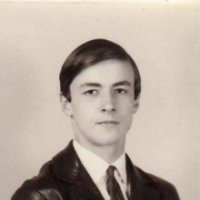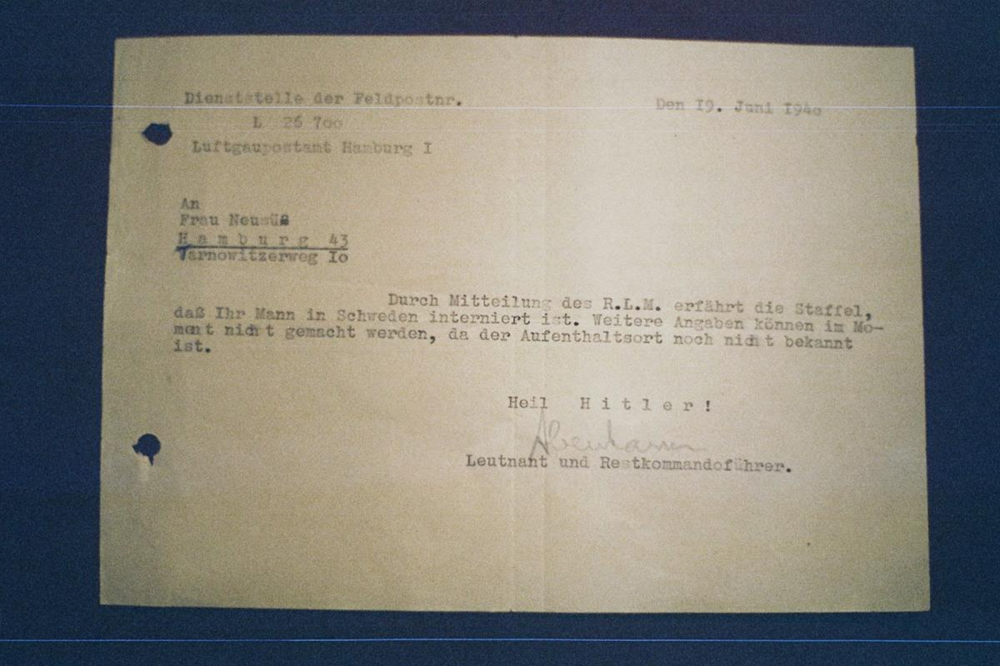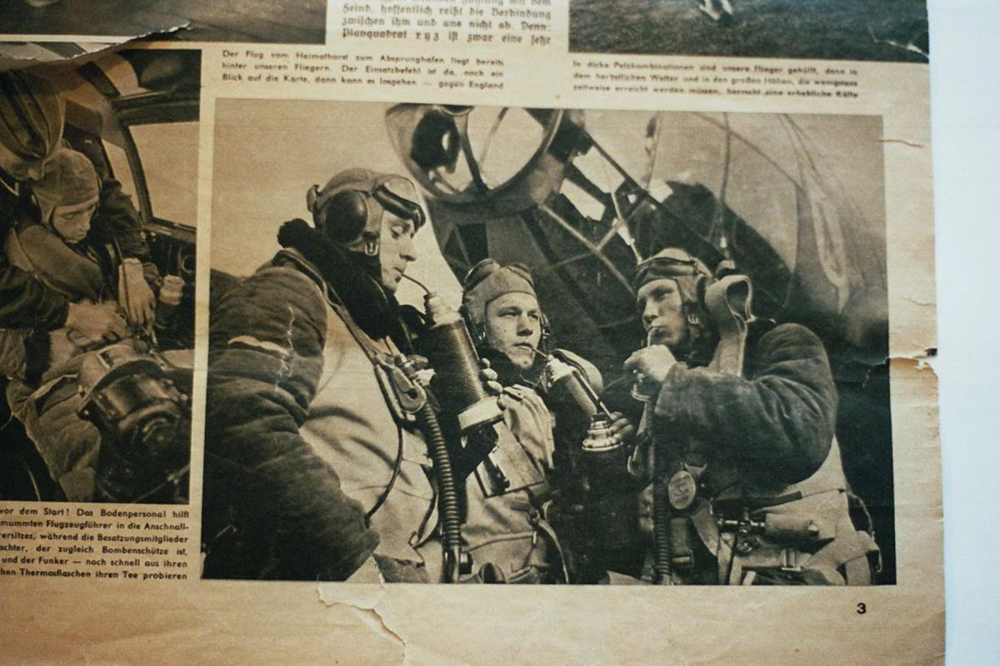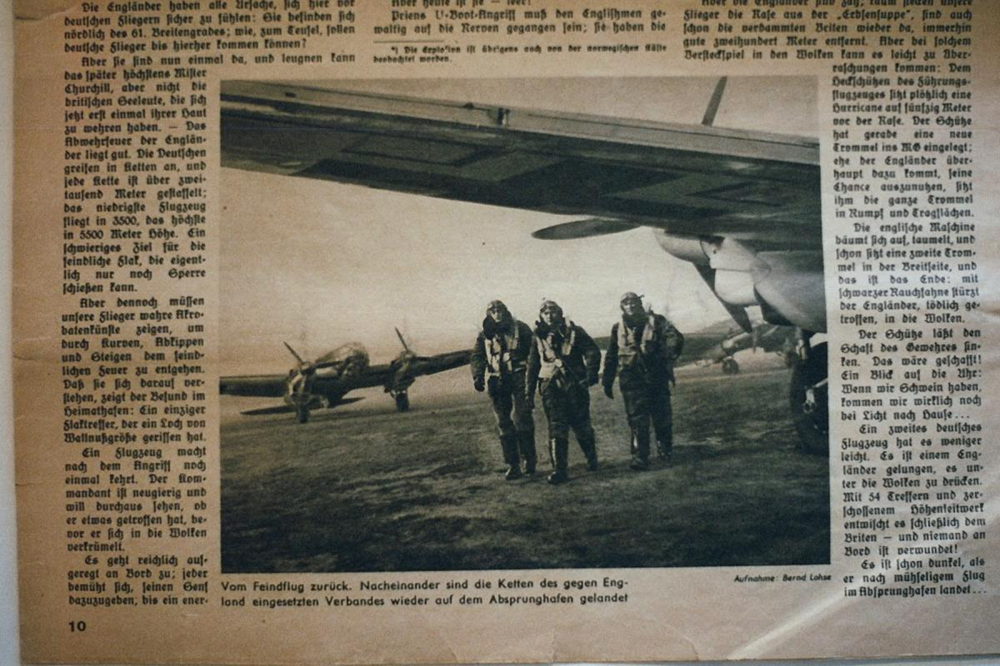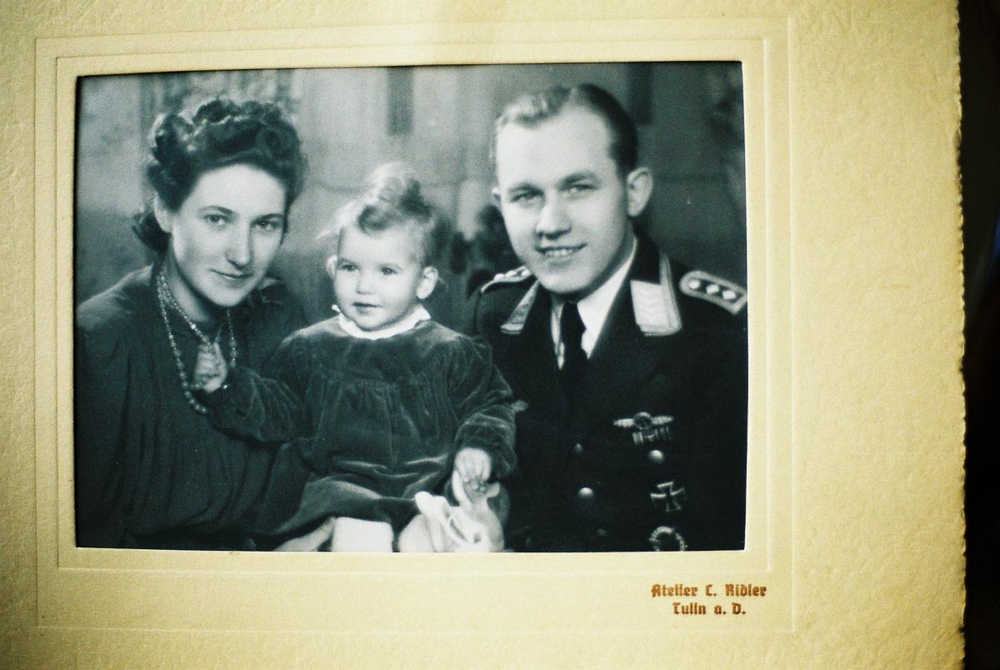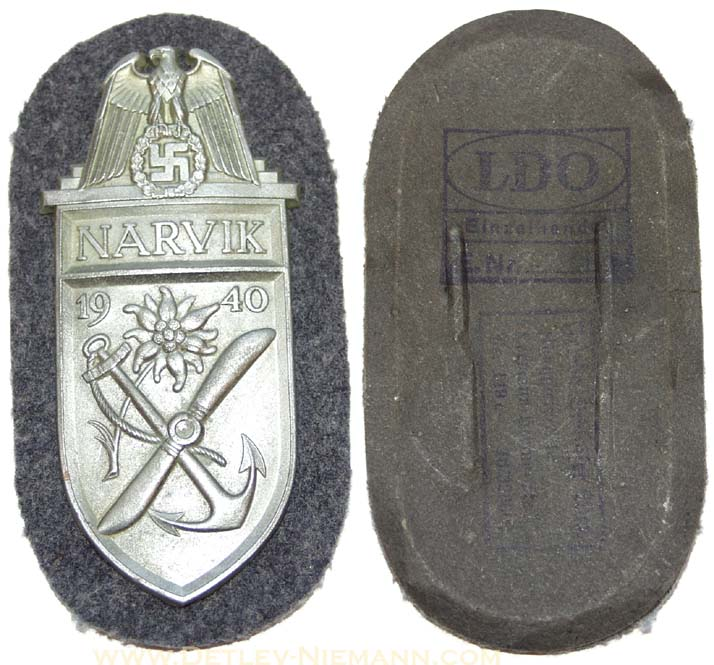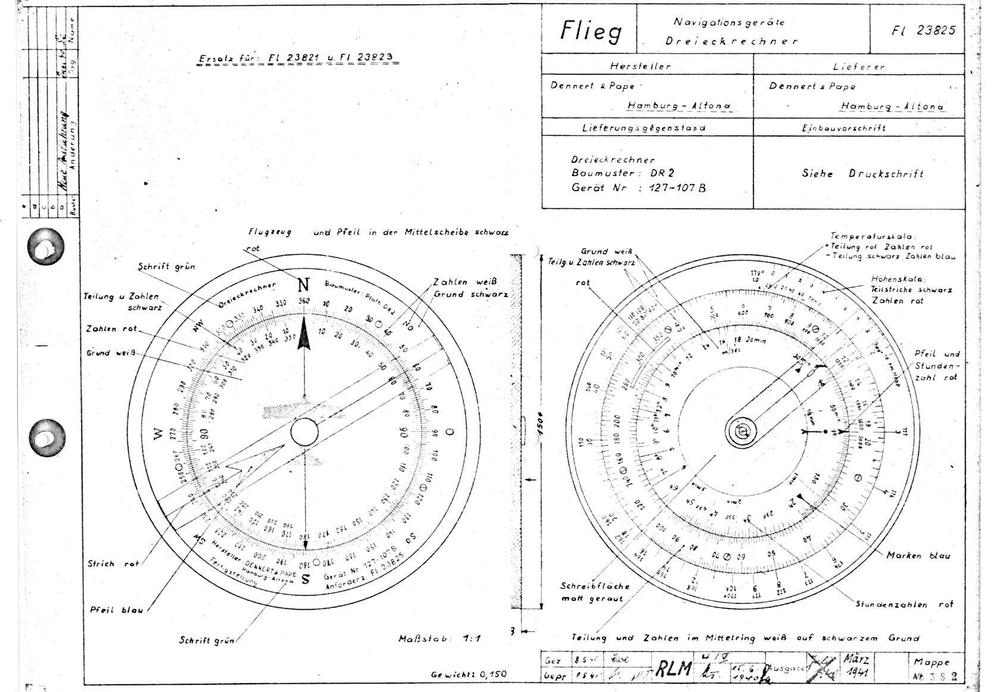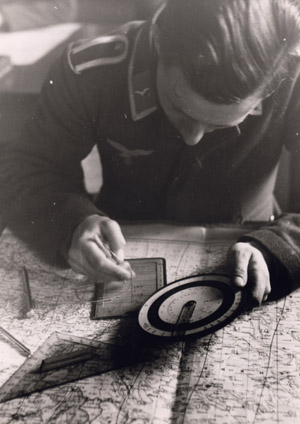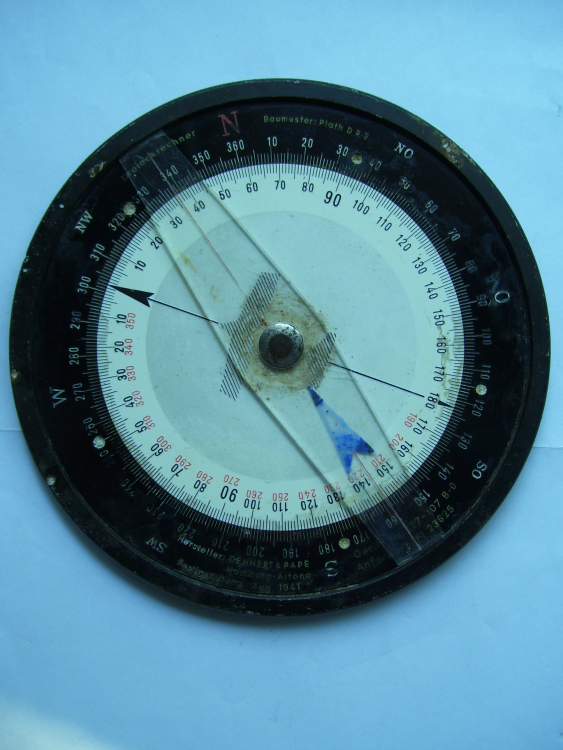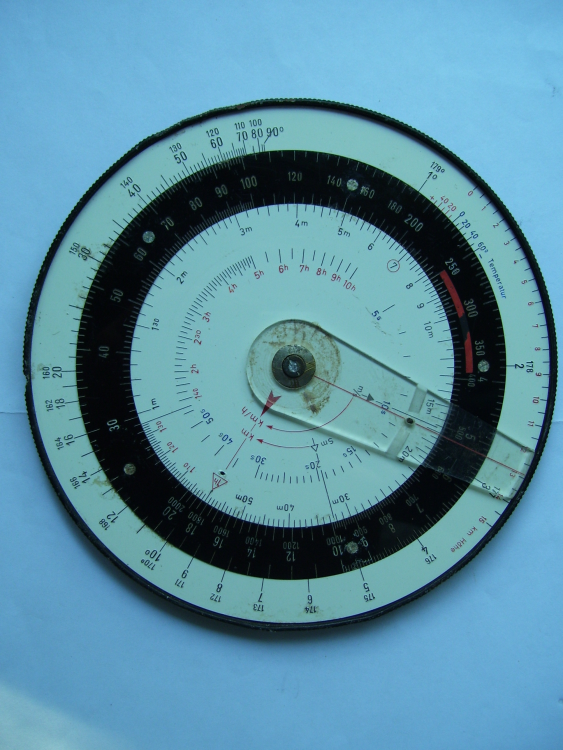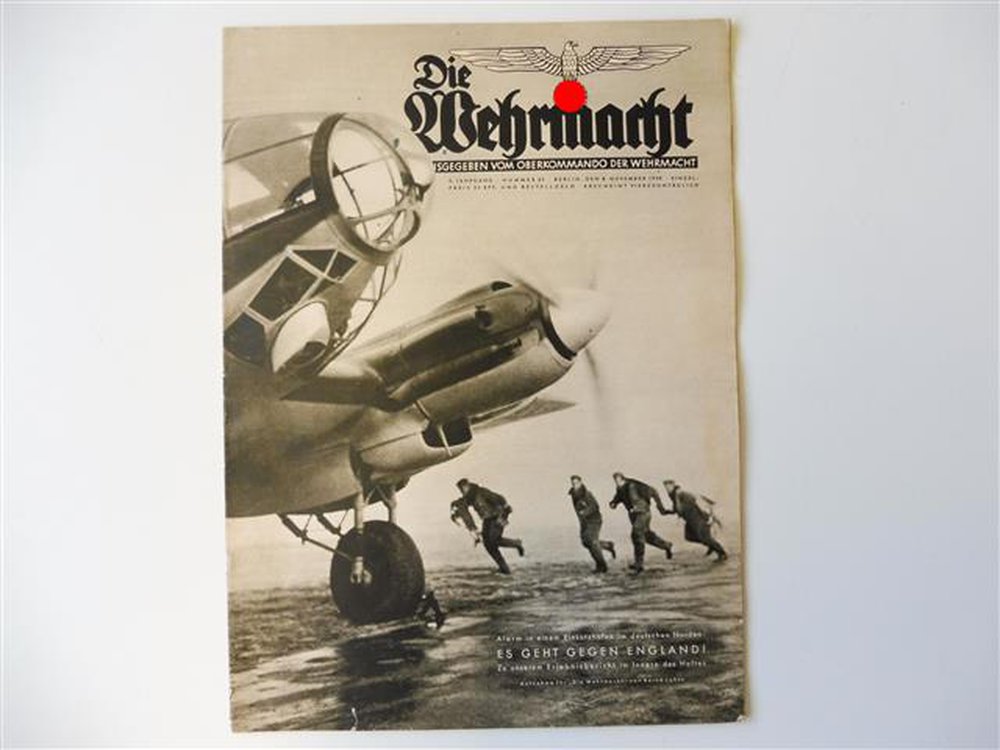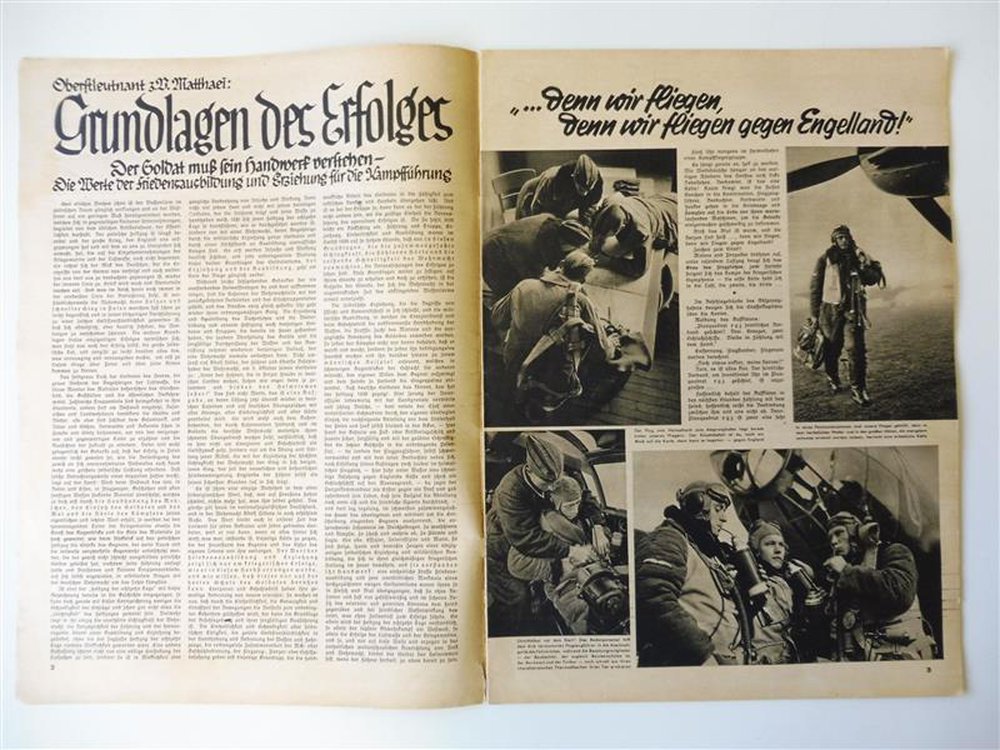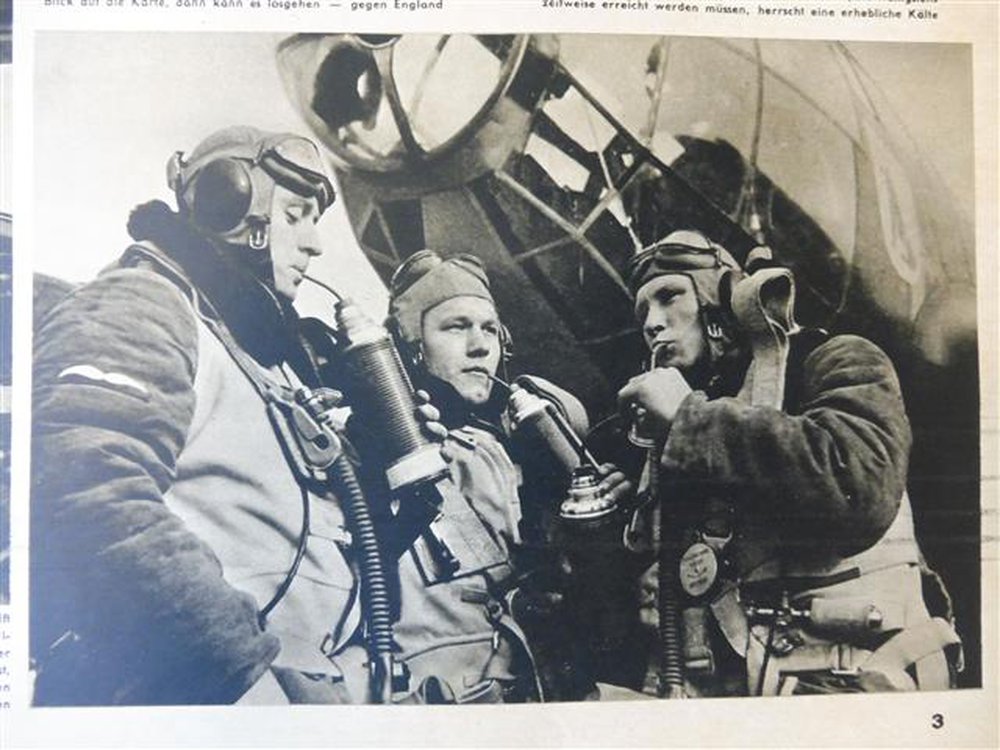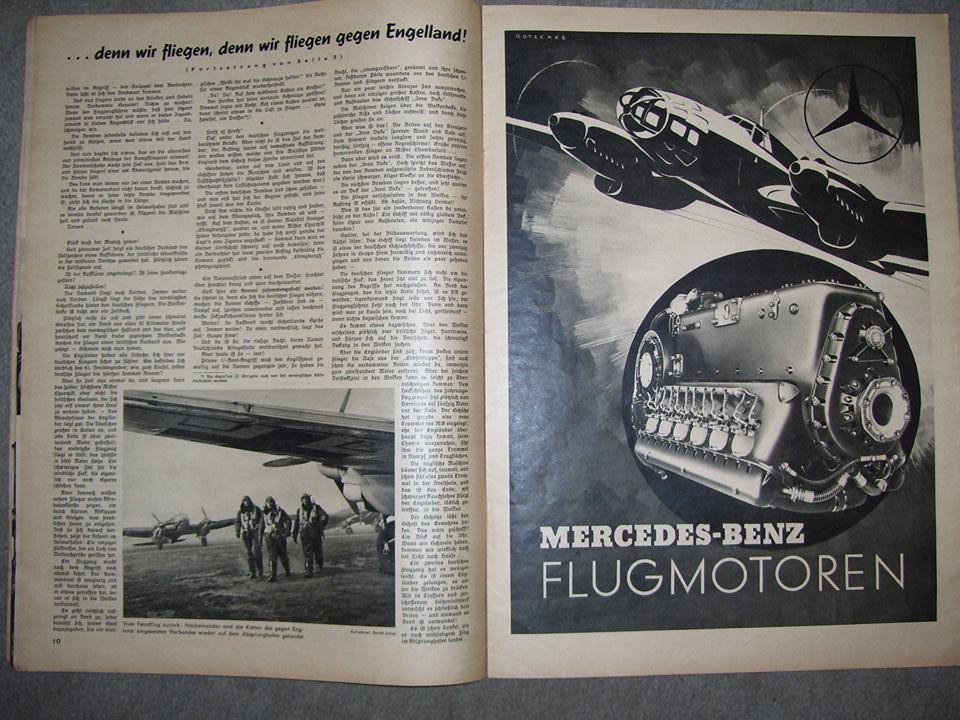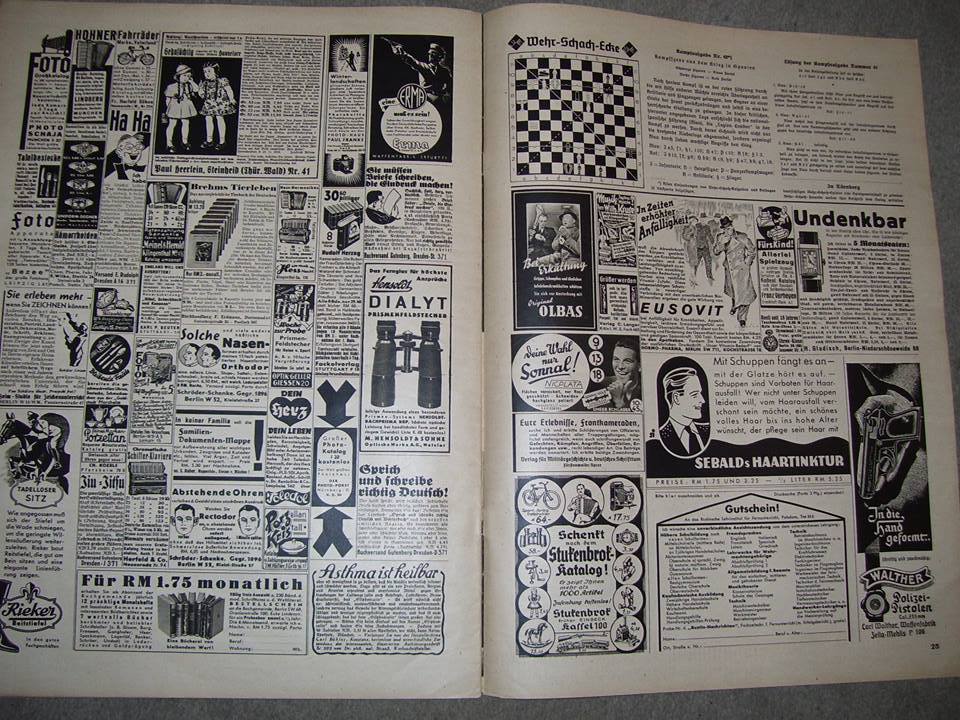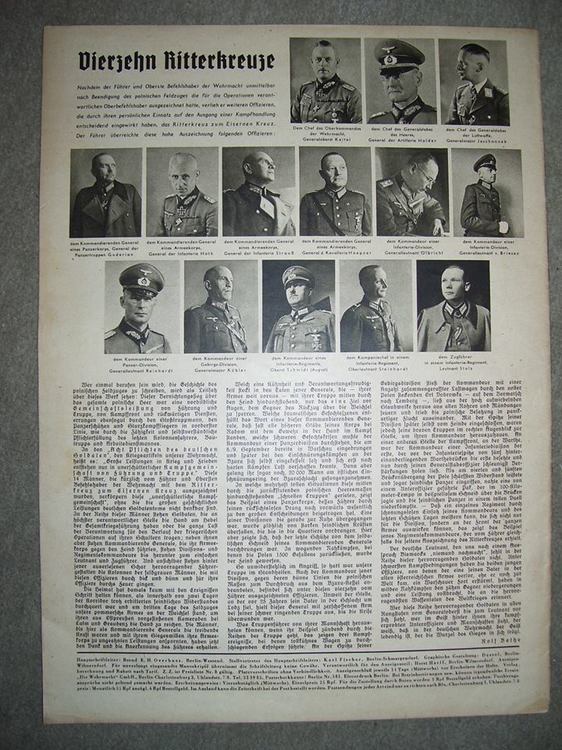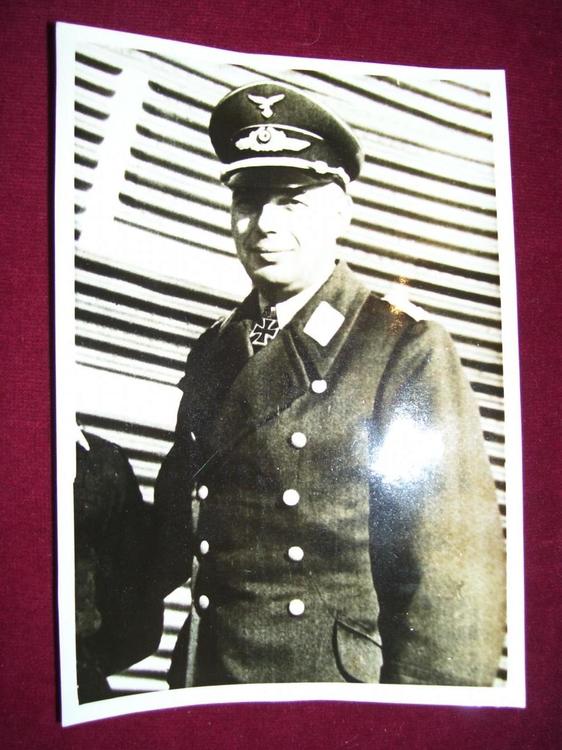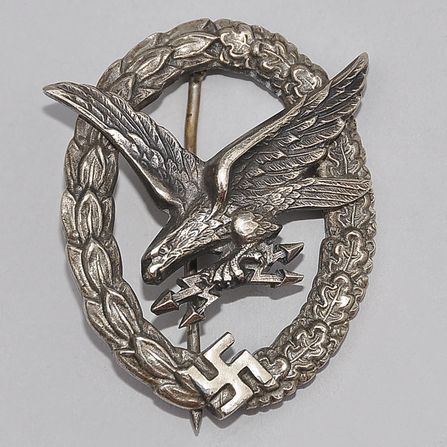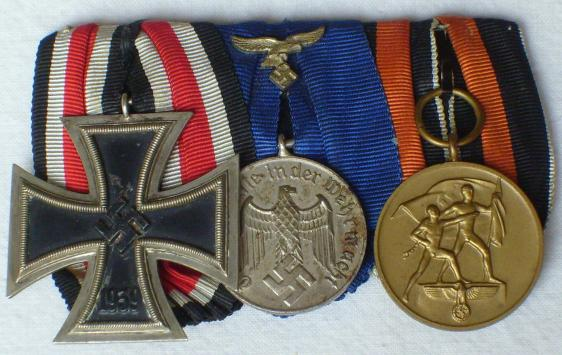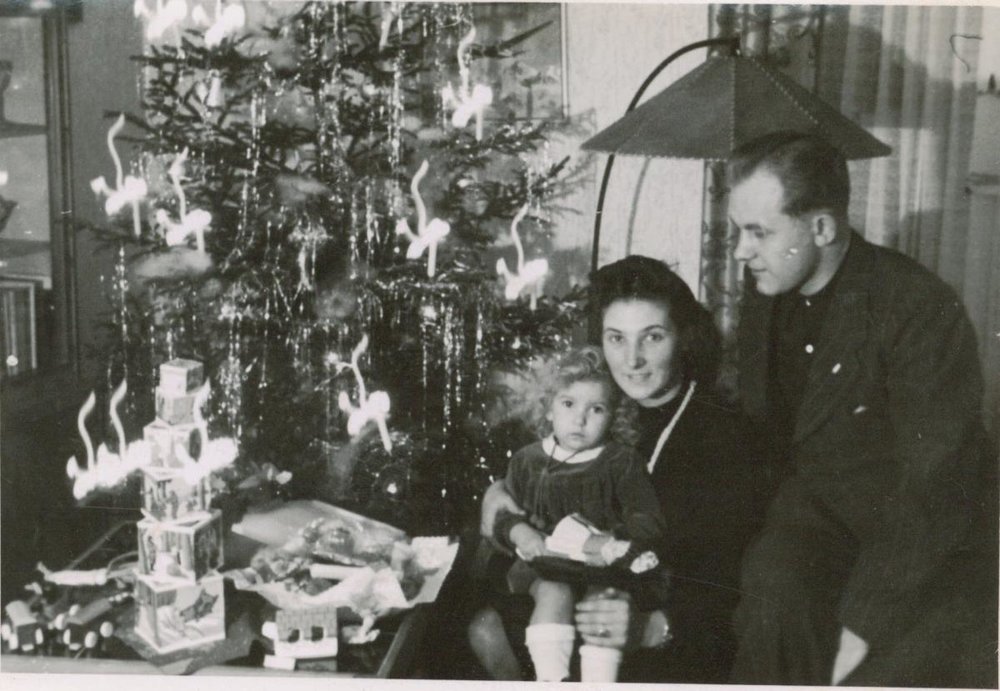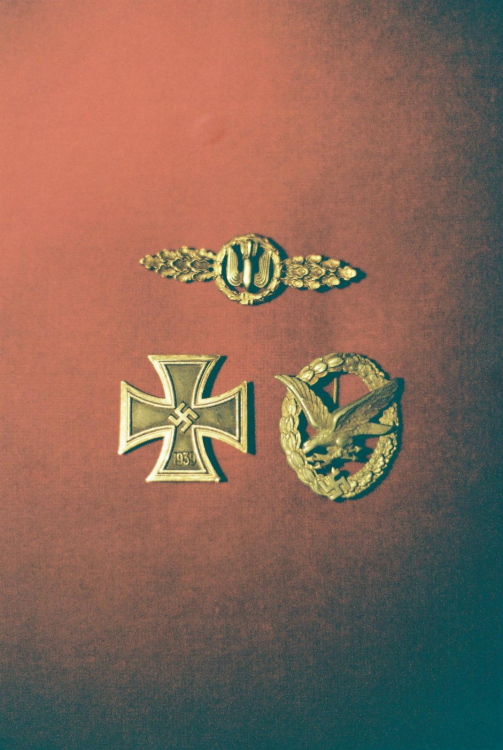Search the Community
Showing results for tags 'walter neusüß oberfeldwebel'.
-
Unteroffizier Walter Neusüß posted missing, 29.5.1940 This is an original document dated 19.6.1940. It was given to me personally by Liesel Paulmann (née Gottwald, gesch. Neusüß) on 19.6.2006 - 66 years after it was written. The document is addressed to Liesel Neusüß, sent by Luftgaupostamt Hamburg I, Dienststelle der Luftpostnr. L 26 700. It is signed by a Leutnant and commander of the "remainder" - name Abenhausen The addressee was at Hamburg 43, Tarnowitzer Weg 10 Liesel Neusüß was living there at the time with her parents, Alfred and Martha Gottwald. The house was later bombed out in 1943. Most personal possessions were lost. Later, Liesel was safely living in Langenlebarn, (Luftkriegsschule 7) in the Fliegersiedlung. Hamburg 43 no longer exists, it is now 22049 Hamburg (Dulsberg). The text: Dienststelle der Feldpostnummer Den 19.6.1940 L 26 700 Luftgaupostamt Hamburg I An Frau Neusüß Hamburg 43 Tarnowitzerweg 10 Durch Mitteilung des RLM (Reichsluftfahrtministerium), erfährt die Staffel, dass Ihr Mann in Schweden interniert ist. Weitere Angaben können im Moment nicht gemacht werden, da der Aufenthaltsort nicht bekannt ist. Heil H i t l e r ! Abenhausen Leutnant und Restkommandoführer Translated: Through information of the RLM (Reichs Air Ministry), the Wing has learned that your husband has been interned in Sweden. Further details can not be made at the moment, as his whereabouts is not known. HH etc. Abenhausen A nice old document from the family, about the only thing left from the old days, unfortunately has been punched at some time, but otherwise in good condition. Further photos are from an old period magazine from around early 1940, unfortunately cover and some pages missing, but the central article is about The raids over the North of England, Scotland, incl. Scapa Flow and Firth of Forth. It is known that these raids took place between mid October 1939 and January-February 1940, possibly also March. It is not metioned which squadron took part, and no personal names, but the family recognised Walter Neusüß and therefore this magazine was part preserved for so many years. It is probably the magazine Die Wehrmacht, but not certain. The next photo shows three airmen in front of their Heinkel He-111, taking a sip of tea from their thermos flasks. The man in the middle is Unteroffizier Walter Neusüß. Note the heavy flying gear and the thick dark flight overalls (Winter period). The other two men are unknown, but later W.N. flew with Oblt. Egon schmidt (Pilot), Fw.Walter Lippe Uffz. Herbert Ranscht (+) The flight from, presumably Lübeck-Blankensee to Firth of Forth and Scapa Flow, was a very long and hazardous flight, undertaken partly in darkness. The reconnaissance aircraft which preceeeded them, disappeared and was never heard from since. There must have been a great feeling of fear and tension throughout. No wonder Walter Neusüß flew for the last time at the end of 1941, and had ground duties the following year. The third photo shows the crew on the way to their aircraft, the man in the middle, is again, Walter Neusüß.. (orig. photos by Bernd Lohse of R.L.M.) N.B.: Uffz. Neusüß went missing after his aircraft was attacked by a Hurricane whilst flying near Rombakken Fjord, near Narvik. The crippled aircraft made a forced landing near Beisfjord, 30 km from Narvik. Herbert Ranscht died in aerial combat. The aircraft was set ablaze. The remaining crew were briefly captured by French troops, but managed to escape and crossed the Swedish border, where several days later in Sjangeli, they were taken into internment, probably held at Kiruna, until returning on 12th July 1940. Walter Neusüß was sent straight to Kampfgeschwader Gen. Wever No.4 Signature: Abenhausen Walter Neusüß (centre) Walter Neusüß (centre)
-
Wartime propaganda films. Very realistic
-
Tulln/Donau, Autumn 1942 This photo was taken in the photo studio, Atelier C.Ridler in Tulln in the Autumn of 1942. This is the Neusüß (Neusüss) family In the picture are Oberfeldwebel Walter Neusüß, 4.7.1914 - 25.8.2009 Liesel (Luise) Neusüß, geb. Gottwald, 8.2.1919 - 4.8.2011 Birgitt Neusüß, 20.11.1941 - 10./11.9.2009 The family lived at the time in the Fliegersiedlung in Langenlebarn, next to the airfield and the Luftkriegsschule 7.
-
Grotli, Norway, 27. April 1940, Norwegian film from 2012. From a true story of a forced landing near Narvik, April 1940.
-
This picture was taken in late 1939 or early 1940. Kampfgeschwader 26, known as Löwengeschwader (Lion Squadron), whose motto was "Vestigium Leonis" (Lat.: In the sign of the Lion) was based originally at Lübeck-Blankensee, and later near Oldenburg. Shown is a bomber crew. In the middle is Unteroffizier Walter Neusüß with his comrades taking a refreshing tea before or after a raid. The picture was taken at the time of the early raids on Firth of Forth and Scapa Flow, in which the training ship "Iron Duke" was damaged. The picture originates from the periodical "Die Wehrmacht", and was written and photographed by Bernd Lohse of the RLM (Reichs Luftfahrtministerium).
-
A not so well known march - Löwengeschwader - the March of Kampfgeschwader 26 In one of the photos, Walter Neusüß is depicted in an official press photo from around October 1939 (third photo from start of clip). Was very surprised when I saw this. Has unfortunately been deleted by youtube - see further down for another recording, mp3 16.9.2019
-
Narvik Schild 1940 A Narvik Schild in silver, mounted on a bluegrey Luftwaffe cloth backing. The Narvik shield was awarded to all personnel, who took part in the batte for Narvik between 9th April and 10th June 1940. The shield was produced in silver finish for Heer and Luftwaffe, and in a gold finish for the Kriegsmarine, each with its own appropriate backing cloth. Shields were initially produced in pressed iron with a silver or gold finish, later in Zinc. The award for initatiated on 13th August 1940 by order of Hitler, and the first recipient was Generaloberst Dietl on 15.3.1941, the commander of the Gebirgstruppe. By mid 1941 most awards had been bestowed, in all: Heer: 2755 Luftwaffe 2161 Marine: 3661 The Narvik shield, as most others, is frequently copied. Caution is recommended with examples with too new paper backings. The original series had more of a type of felt behind the cloth backing. (photo by D.Niemann,Hamburg)
-
Dreieckrechner A Luftwaffe navigation instrument as always part of the personal items taken on board, mostly larger aircraft with more than the pilot. This, officially known as a Dreieckrechner for calculating various aspects of navigation, position, altitude, speed and wind. It is two sided. It was first patented by C.E.Plath (Nautical Instruments) of Hamburg-Altona in 1936 and produced by Dennert & Pape of Hamburg-Altona, both firms are, as far as I know still in existence. This item was first introduced as "Baumuster Plath DR2" in 1936 with the designation Fl.23825, which was a special number for Luftwaffe equipment, so that orders for replacements were made using these LW Codes. Also still known as a "Knemeyer" after its original designer. This particular example was produced in August 1941. It has suffered a bit from postwar bad storage, but still fully functional for those who are familiar with it. This is the basis of modern instruments as still produced by these companies and in use today in modern aviation, with the designation "Aristo". Further models were produced in 1942/3 as DR3 and DR4 as from 1944, in use till the end of the war. A special variation in slightly luminous yellow for night flights was also later produced. A copy of an original instruction leaflet shows and explains the various parts of the instrument and its functions. Not sure which member of the crew had the function of navigating. Either the Observer, Bordmechanik or Bordfunker. I remember Ms. Neusüß explaining to me that Walter Neusüß as Bordfunker also was sometimes involved with "Navigation". (transferred from equipment section)
-
Finally found the magazine I have been looking for for years. As I had only been able to photograph the remaining pages of a partly surviving copy, I was not certain which publication or issue. For a long time I suspected it could be the magazine "Die Wehrmacht" (publ. by Oberkommando der Wehrmacht), and was either late 1939 or at the latest May 1940. This I discovered last week at an internet address in Speyer (Rheinland-Pfalz, city with a famous romanic cathedral). The magazine turned out to be issue 23 from 8. November 1939 of Die Wehrmacht. The reason for my interest was the article about Kampfgeschwader 26 and Walter Neusüß, who is depicted in the photos, some of which I include here, as also appeared in previous articles under his name. Walter Neusüß is the man in the middle of the group of 3 airmen. The pages of adverts from the period are also very interesting. The back page shows the first 14 Ritterkreuze awarded after the outbreak of war. Some names will be familiar to the readers. The magazine appeared twice monthly and was discontinued as from about mid 1944. (8.5.2017) Centre, Walter Neusüß Centre: Walter Neusüß
-
Original press photo of Oberst Robert Fuchs, Kommodore of Löwengeschwader - Kampfgeschwader 26 from 29. September 1939 till 15. October 1940. He received the Ritterkreuz from Hitler on 6. April 1940 for the outstanding services of his squadron with its attacks on shipping in the North Sea and the Channel. Unteroffizier Walter Neusüß also took part in these actions, later promoted to Oberfeldwebel. See previous related topics. The text to the rear of the photo is: Kommodore des Löwengeschwaders mit dem Ritterkreuz ausgezeichnet. Der Führer und Oberste Befehlshaber der Wehrmacht verlieh Sonnabend dem Oberst Fuchs, dem Kommodore des bekannten Löwengeschwaders, das Ritterkreuz zum Eisernen Kreuz. Oberst Fuchs (u.B.) wurde diese höchste Auszeichnung zuteil in Anerkennung der Kampfleistungen seines Geschwaders, das durch seine kraftvollen Angriffe gegen die britische Seemacht sich besonders hervorgetan hat. 7.4.40. PK. F 508 Wb. "KG" Es ist zu nennen: Foto: PK.-Ruge (Weltbild) "Fr.OKW" The photo was apparently the copyright of the publishers Weltbild Verlag, which still exists today (Augsburg). Ruge was probably the photographer. "Fr.OKW" probably stands for "Freigabe durch die OKW" - passed by OKW censor. (31.1.2017)
-
Luftwaffe Badge for qualified Radio Operator, known as Bordfunkerabzeichen, or sometimes as Fliegerschützenabzeichen mit Blitzbündel. This example by C.E.Juncker, Berlin SW. The badge is an earlier make of so-called German Silver or Neusilber and in fine quality by this premium maker of long standing. Later examples were made of Zink. Introduced on 26th March 1936 for qualified personnel, it was also awarded to unqualified personnel, who had distinguished themselves in action over so many missions. This was also awarded to flight mechanics and air gunners until December 1941, when a new badge without the lightning strokes was introduced
-
The Iron Cross has no traces of any silvering (cant see maker as ring is hidden under ribbon), but is made of white metal (Neusilber) and the iron core has a thin black lacquer showing no traces of rust. Is however, an awarded piece and not a second. The Dienstauszeichnung is iron with most of silvering present, just a few little rust stains between some ot lettering of Wehrmacht and is mounted with the Luftwaffe eagle second pattern, which appears to be made of zinc with most of hard silverplate present, which would deem it a midwar variation. The Sudetenland medal has lost some of its finish, but is solid bronze, and these were only awarded up till early 1941. It has no Prague Castle bar. These are on a black cloth backing with a wide needle pin and hook. Original wearer not known, but could have been an airman, as this was a typical combination for airmen, who had served since at least 1938. Oberfeldwebel Neusüß of KG26 and KG4 also had this combination of decorations, but there is no photo of him wearing such, just the simple small ribbon bar in several photos, the ribbons of which are clearly recognisable. Hard to find in this combination nowadays. Many servcemen never got their medals mounted and just wore the ribbon bar. In Germany it has been prohibited since 1945 to wear any decorations. Certain decorations were permitted as per the 1957 laws, and these being remanufactured without swastikas. The Sudetenland medal is however, prohibited in any form, as are many other decorations. These laws now also apply to Austria and France. However, there are hardly any more veterans left to comply to this.
-
A film about the production of the Heinkel He 111. At the beginning is an action scene and mention of the early attacks on Firth of Forth and Scapa Flow - carried out by Kampfgeschwader 26 with Unteroffizier Neusüß. Main production centres were Rostock and Oranienburg. 17 min. 21 sec.
-
Walter Wilhelm Franz Neusüß (95) passed away after an emergency operation in the Marienkrankenhaus Hamburg, after breaking off his family holidays in Grömitz near Lübeck. Just 16 days later, his daughter, Birgitt Baxmann, neé Neusüss died suddenly at her home in Hamburg. Unfortunately help came too late for her. We, the family are very grieved. She never came to hear of the death of her father, which was kept secret by his present wife, who is much younger and runs the family business, which he started in the postwar years. Walter Neusüss was buried at sea from Grömitz. Birgitt was laid to rest at the Old Wandsbeker Churchyard, just near the tiny cemetery chapel on midday on Monday, 28th September 2009. Her two daughters, B**** and N***** and myself are unconsolable. Paul (Fritz)
-
Weihnachten, 24. Dezember 1943 Picture above reads on reverse side "The three Langenlebarner under the Christmas Tree, 24.December 1943" Depicted is Birgitt Neusüss (20.Nov.1941-10./11.Sept.2009) with her parents in the "Luftwaffe settlement" at the flying field Langenlebarn near Vienna (Luftkriegsschule 7, Tulln-Langenlebarn) Her father was Radio Operator (Bordfunker) and reached the rank of Oberfeldwebel, at first with Legion Condor in Spain (?), then K.G.26, K.G.4 and as from May 1942 with LKS 7. He flew over 283 missions and had the iron cross 1st class, the Bomber Crews Clasp in Gold (Frontflugspange für Kampfflieger in Gold), Narvik Shield, etc. Became a prisoner of war near Salzburg/Austria, returning from American captivity around the end of 1945. He passed away on 25 August 2009, just two weeks before his daughter. He spent most of his spare time with his family, and preferred to do so in civil clothing.
-
Liesel Neusüss in Königsberg, February - April 1942 Walter Neusüß flew until around end of 1941. After sustaining a further wounding, he was from around January till end of April 1942 in or near Königsberg, firstly for treatment and recovery and then presumably for further training. The wounds he had probably received on the Eastern Front, at the time Kampgeschwader 4 was operating in various sectors in Russia. After the wounds he was no longer with Kampfgeschwader 4. From February till April 1942 his wife came from Hamburg to be nearby. The little daughter, Birgitt, stayed with the grandparents Alfred and Martha Gottwald in their home in Tarnowitzer Weg 10 in Hamburg-Dulsberg. Liesel stayed in accomodation with the family of Adalbert Bedarf in the Kurfürstendamm 3. A photo records this, and can be seen on this article. Walter and Liesel were able to visit some interesting places in Königsberg, such as the castle, Königsberger Schloss. There are a couple of photos which record their visit to that place together with a comrade and his wife (may be posted later) At the beginning of May 1942 the family (all three) moved to Langenlebarn into the family quarters at the airfield and Luftkriegsschule 7 (Tulln). Walter had his duties as Peilfunkleiter and Leiter der Flugberatungsstelle, retaining his rank of Oberfeldwebel. At the same time, he had much more time for wife and daughter and all spent a few happy years, before the evacuation on 2nd April 1945. The photo shows Liesel Neusüß with her host family in Königsberg, Kurfürstendamm 3, early 1942 The family of Adalbert Bedarf ran an inn with restaurant. They are recorded in a census for the year 1934 as being at that address and with that profession. The fate of that family in 1944/45 is not recorded. The Russians have occupied the area and are still there today (Kaliningrad). The city of Königsberg was totally destroyed and the historic castle was burned out in July 1945 and demolished by the Russians in 1950. All that remains are the cellars, where the famous Amber Room or Bernsteinzimmer is thought to have been kept. This has also disappeared without trace till today. Last picture shows the courtyard and cellar of the Königsberger Schloss. The cellar was a well-known restaurant known as the "Königsberger Blutgericht". This photo from early 1942 shows Walter Neusüß and a comrade with their wives.
-
Two soldiers of the Luftwaffe shot down in 1939 near Firth of Forth, funeral at Portobello. This was probably around 16th October 1939, raid and reconaissance by 2./Kampfgeschwader 26 - Unteroffizier Seidel (or Seydel?) Flieger Schleicher as stated by commentator (see also articles about Walter Neusüß, who took part in these actions) worth researching: Another clip, this time in England, May 1940, Pathé Newsreel, apparently there are four airmen:
-
Two memorials for two World Wars in the small town of Uichteritz an der Saale, near Weissenfels, environment of Leipzig. For such a smal town, there is a very long list of casualties for both wars. One of the first of these casualties of WW2 was Herbert Ranscht, born 8.6.1915, Unteroffizier of 2./ Kampfgeschwader 26, who fell in aerial combat over Rombakken-Fjord near Narvik on 29. May 1940. He was a Kamerad of Walter Neusüß, and was the only one of the crew who did not survive the ordeal of this aerial combat. Ranscht was Bordmechaniker on the He 111. When the machine made a crash-landing near Beisfjord, 30 km from Narvik, he was already dead. I learned that one and a half years later, he was recovered and interred in the German War Cemetery (Soldatenfriedhof) in Rombakken-Fjord. Ranscht is the second name on the top far left. The memorial sight in the photo was errected just some years ago, which would not have been possible under the circumstances before the re-unification in 1989/90. In those days no-one was allowed to mention the war dead, or anything at all. "Verherrlichung des Faschismus" (glorification of faschism and war) was considered a crime punishable by death in the years of communist dictatorship. The third memorial depicted is for the war of 1870/71.
-
Today, Sunday, 20. November is in Germany - Totensonntag - a day in which families (Lutheran and Reformed Churches) remember their loved ones. Last Sunday, 13. November was Volkstrauertag, a day, in which the fallen of two World Wars are remembered, the memory gradually diminishing over the years, and finding continually less acceptance. The 1. November is the day in which German, Bavarian and Austrian Catholics remember their loved ones, known as Allerheiligen or All Saints Day. The 9. November was also a very fatefull day in German history. Today is also a birthday of someone no longer present
-
Anniversary 10 years Walter Wilhelm Franz Neusüß * 4. July 1914 + 25. August 2009 See article from October 2009
-
Passierschein, Soviet Zone, 1947 Passierschein in German and Russian, issued by the Soviet Stadtkommandant or Ortskommandantur in Chemnitz in December 1947 for crossing the Zone Border for a return home to Hamburg at the latest by 18.12.1947. In later years the function of this document was fulfilled by a Transit Visum. Liesel Neusüß was on a visit to Chemnitz (Saxony), which lay in the postwar Soviet Zone SBZ (Sowjetischische Besatzungszone). In the early postwar days you could travel around with the relevant papers into the Soviet Occupied Zone, entirely at your own risk. It was not unusual for people being abducted and disappearing. Soviet Greifkommandos were constantly roving around for many years, until the borders of the Iron Curtain finally closed. Liesel Neusüß had known the Guttmann family, who came from near Chemnitz (Hartmannsdorf), since their wartime days in Langenlebarn, and both their families had together faced the ordeal of returning home as refugees. This document I photographed several years ago. Liesel had kept this with her papers for so many years. The papers then remained with the grandchildren. I hope these will be well looked after. Chemnitz was later re-named Karl-Marx-Stadt. After 1990 it was officially Chemnitz again.
-
A typical Luftwaffe airmans decorations - Iron Cross 1st Class 1939 Eisernes Kreuz, 1.Klasse, 1939 - Radio Operators Badge Bordfunkerabzeichen, also known as Fliegerschützenabzeichen mit Blitzbündel - Clasp for Bomber Crews in Bronze Frontflugspange für Kampfflieger in Bronze The EK shown has no makers mark, and the catch for the pin has been expertly repaired at some stage. The recipient has had his initials and the date of the award very stylishly engraved at the back, being: P.S. 4.I.1941 this done in a rope-like style of gothic script. Possibly researchable. The finish is completely worn off the swastika, and the whole decoration shows light wear. The Radio Operators Badge has lost a lot of its finish and is a Zinc example by B&N,L Berg & Nolte in Lüdenscheid, the pin has been repaired and the eagle has come adrift at some time and been crudely soldered onto the wreath, with solder marks to the rear of the badge, otherwise a reasonable example from the front. The Bomber Clasp is of earlier bronze metal with a german silver centre piece riveted as always. The pin construction to the rear is of the usual cokebottle variety and is also of the early german silver type. There is no makers mark. This decoration was inaugurated on 30th January 1941 and was awarded in three classes, bronze for about 20 missions, silver for 60 missions, and gold for 110 missions. Additional hangers in gilt with a number were also awarded as from 200 missions. Later examples were made in Zinc, which mostly loses its finish in the course of time.
-
Veteran 95th Birthday on 4th July last Illustrious veteran Walter Wilhelm Franz Neusüss, born 4. July 1914 in Hamburg, celebrated his 95th birthday on 4th July 2009. Walter Neusüss entered the newly formed Luftwaffe as a volunteer, taking part in the Spanish Civil War with the Legion Condor. At the finish of this war, in Autumn 1939, he joined the newly-formed Kampfgeschwader 26, known as "Löwengeschwader" in Lübeck-Blankensee. This squadron took part in minor raids in Autumn 1939 over Firth of Forth and even Scapa Flow, about 14th October 1939. The next major event was the battle of Narvik (Norway), starting on 9th April 1940, after which the squadron flew raids in the direction of Narvik from it's newly attained base in Stavanger-Sola. On 29th May 1940 in the early morning hours, the Heinkel He111, 1H+FH was shot down along with another He111, 1H+LK by two Hurricanes flown by Drummond and Jameson of 46. Squadron RAF. He mentioned recently the markings on one of his planes being: 1H+GK, and there exists a photo with just these markings. The Heinkel in which Unteroffizier Neusüss was radio operator and gunner crash landed 30 km from Narvik, near the Swedish border. One of the crew, the board mechanic, Unteroffizier Herbert Ranscht had been killed in the battle. Other crew members were, Pilot: Oberlt. Egon Schmidt, and observer: Fw. Harald Lipp. The surviving crew were captured by French troops (as I was told), but were able to escape over the border to Sweden, where they were interned two days later at Sjangeli, being held till 12.July 1940, then returning to Germany. This was lucky, as there were many Polish troops in the vicinity and they took no prisoners, as the records of other losses clearly show. Neusüss told that he was then posted right away to Kampfgeschwader 4 (Geschwader General Wever), which must have been stationed in Holland at the time, and have taken part in the Battle of Britain. The following year, about May 1941 Neusüss was posted to the Island of Rhodes ( this must have been the II.Gruppe of KG 4 ), from where raids were carried out against Egypt, Suez and shipping on the Red Sea. He must have been on leave in Summer 1941, being depicted on a such dated photo, being nicely suntanned and smoking a cigar. By 1941 he was already Oberfeldwebel. Later he was on the Eastern Front, where at the end of the year he sustained a wound to the left wrist and hand as well as one knee. He was then in a military hospital from about January till April 1942 near Königsberg, Lazarett Iruna, as he mentioned. Altogether he had flown 283 combat missions and was highly decorated. He was visited by his wife Liesel, who stayed with Familie Bedarf in the Kurfürsten-Damm 3, Königsberg. After recovery he was sent with his wife and baby daughter Birgitt to Langenlebarn near Tulln and Vienna, where he was Stations- and Peilfunk-Leiter with Luftkriegsschule 7, and was able to enjoy life in married quarters in the so-called "Fliegersiedlung" until April 1945, when the Russians were approaching. The base was evacuated and the families left first, making their way out with whatever means could be found. Leaving on 2nd April, they arrived after a harrowing odyssee in Hamburg on 14th April 1945. Part of the way had been made with goods trains carrying wounded and refugees, which were unable to cross into Czech territory as this was no longer safe. Some of the remaining personnel of the base were formed into 2 "Sicherungs-Bataillone" to defend the area, and one of which was set in march in direction of Vienna. Walter Neusüss was captured near Salzburg in the last days of the War by the Americans. His uniform was stripped down, losing all decorations, and he arrived in this "abgerissene Uniform" about 6 months later in Hamburg. In the postwar years he set up a chain of drycleaning shops in Hamburg, often making business trips to Italy to purchase machinery. The marriage broke up in 1947. He remarried in later years, and his present wife still runs one of the businesses. He was able to visit his daughter of first marriage up till a few years ago, but is now wheelchair bound, and recently recovering from a spell in hospital. He still telephones ocasionally with his daughter, and I have also spoken with him several times, and he is still remarkably clear for his age. A wonderful chap altogether. We all wish him the very best and a long and happy life, after what he has been through.


